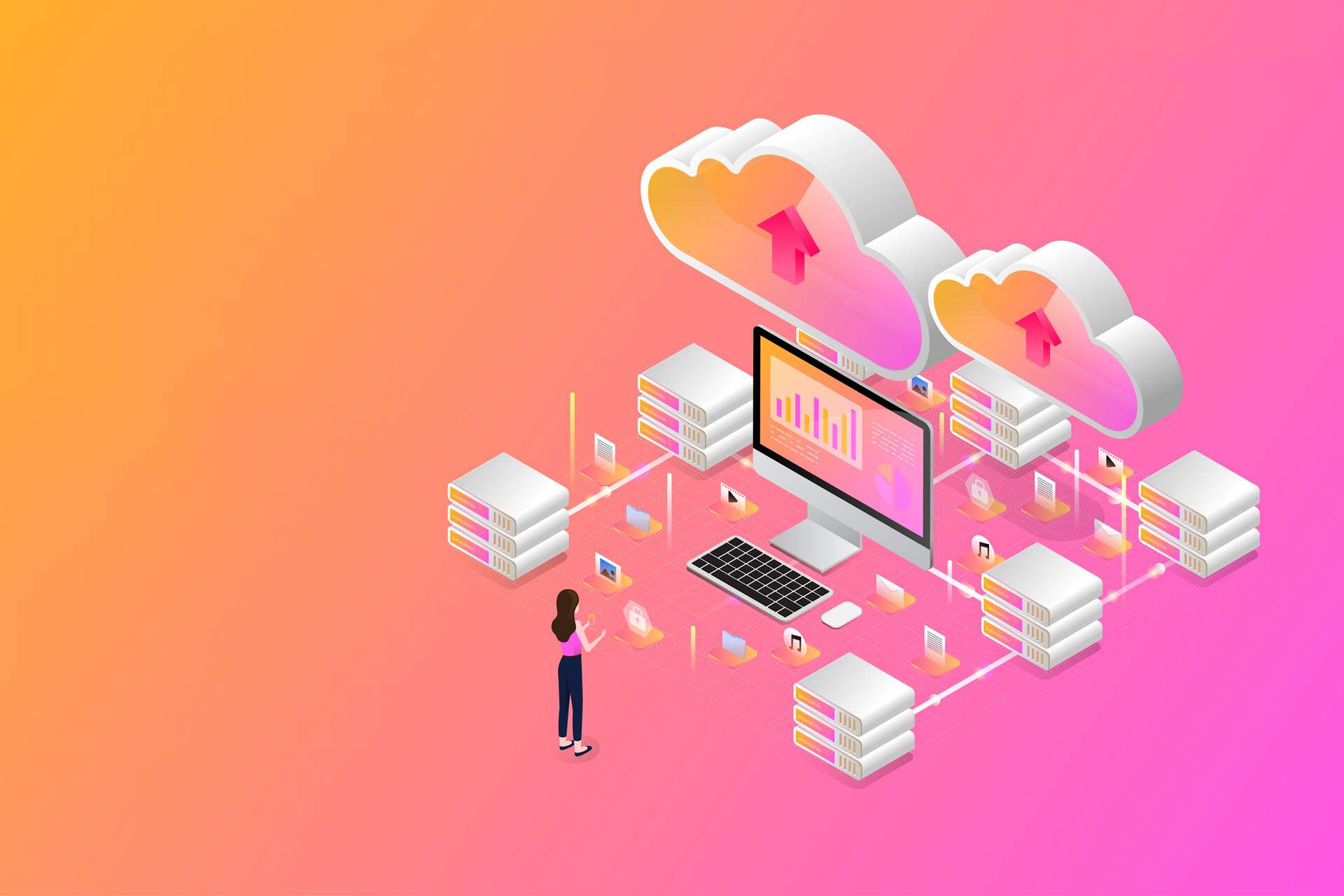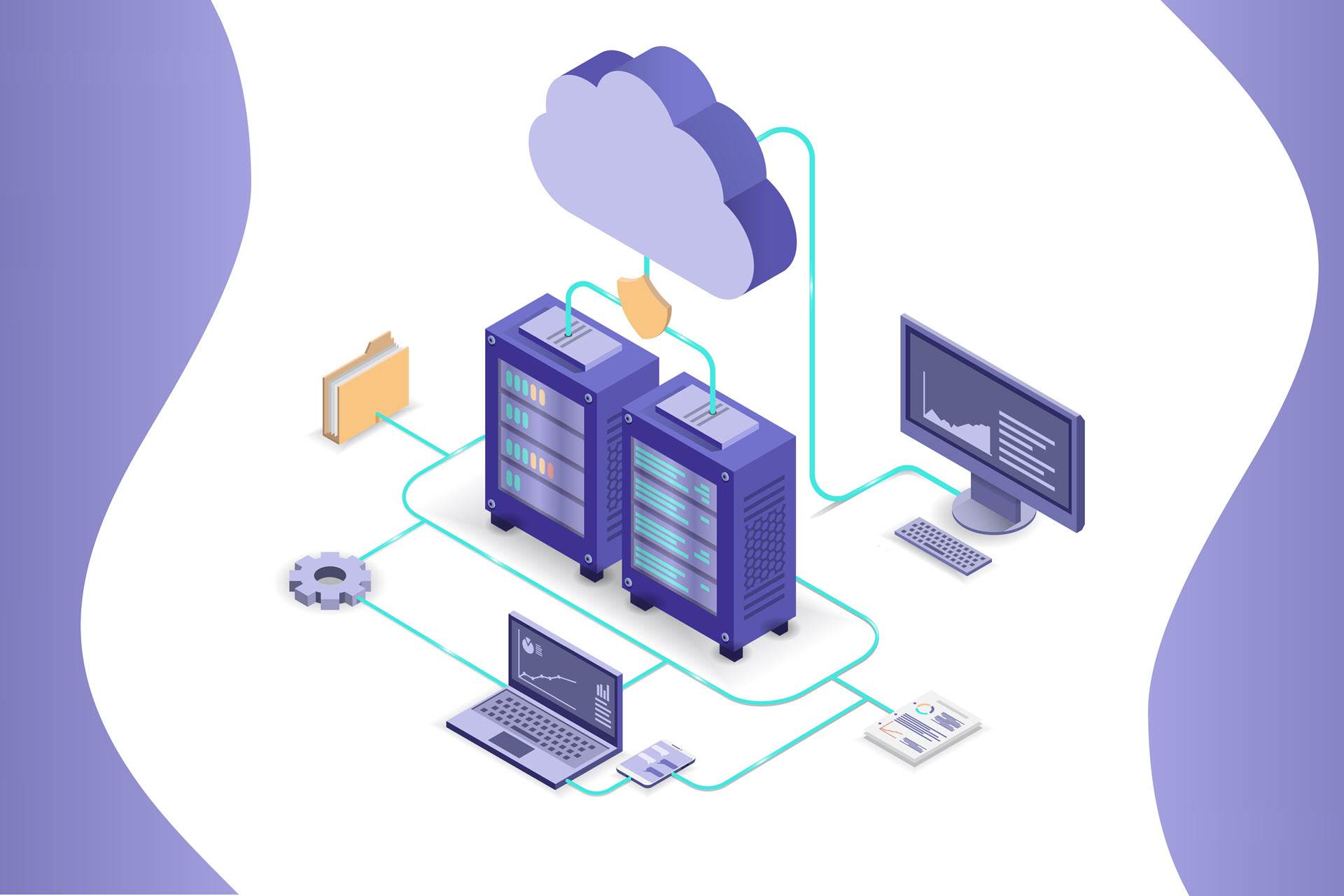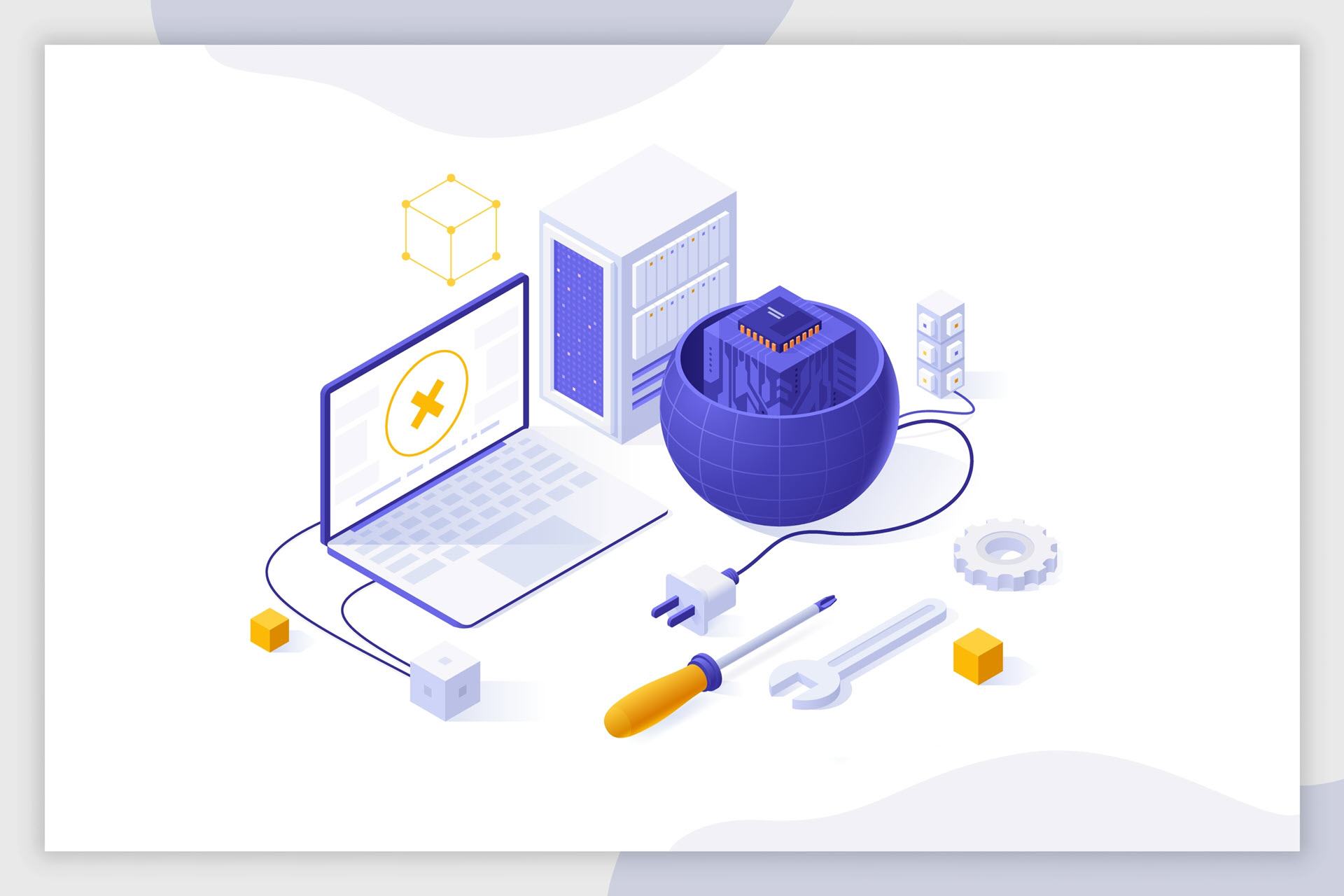Before an organization migrates to the cloud, it is important to understand how the underlying cloud architecture works. At the core of this architecture is virtualization, a tech that drives cloud computing economics and enables users to dynamically adjust resources to their cloud workloads.
This article provides an introduction to cloud virtualization and its role in cloud-based environments. Jump in to learn how virtualization works and see why virtualized IT resources are vital to the efficient use of hardware within cloud infrastructure.
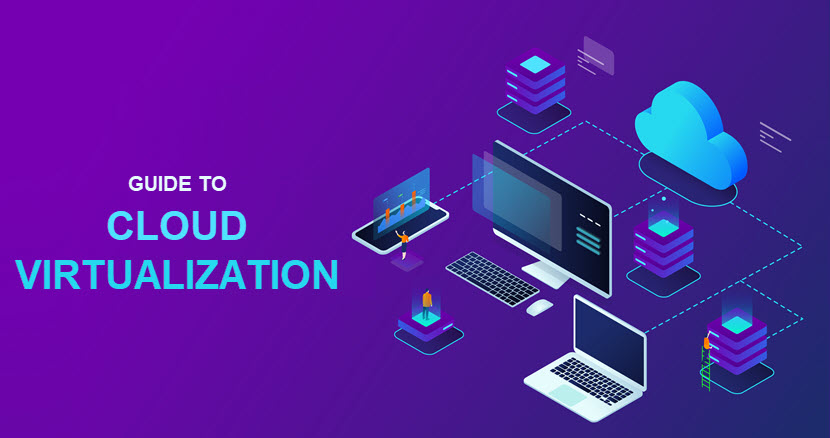
New to the concept of virtualization? Check out our article on server virtualization to get familiar with the idea of abstracting physical hardware components.
What Is Virtualization in Cloud Computing?
Cloud virtualization refers to the use of virtualization within a cloud-based environment. Cloud providers use this technology to create virtual instances of computing resources and deliver them to end-users over the Internet.
Virtualization divides hardware components (processors, memory, storage) on a single server into multiple virtual machines (VMs). Each VM runs a separate operating system and acts like an independent computer despite running on just a portion of the underlying hardware.
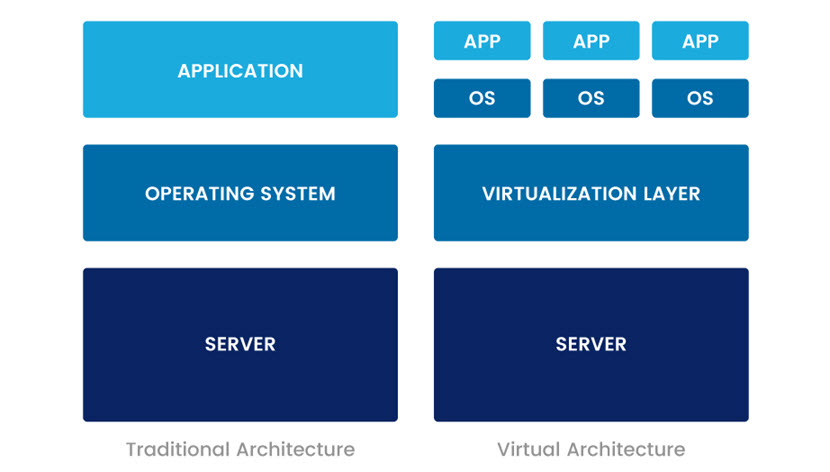
Here's an overview of how cloud virtualization works in practice:
- The provider sets up physical servers and networking equipment in a data center. These resources form the backbone of cloud infrastructure.
- Each physical server runs a hypervisor that allocates physical resources to multiple VMs running on the server.
- While they run on the same server, VMs operate as isolated computing environments. Each VM has its own virtual CPU, memory, storage, and network interfaces and is unaffected by changes or issues in other VMs.
- Cloud users interact with virtualized resources through a web-based interface, API, or command-line tool. Self-service enables users to provision, configure, and manage VMs based on their needs.
- The hypervisor dynamically allocates the physical server's CPU, memory, storage, and network bandwidth to VMs based on current workload demands.
From the provider's perspective, cloud virtualization optimizes hardware usage and reduces costs compared to deploying individual bare metal servers for each app or workload. From the end-user's standpoint, cloud virtualization enables easy resource scaling and improves IT agility. The tech also enables users to pay only for the resources they actively consume, rather than renting entire servers.
Our bare metal vs. VM article outlines the differences between these two server types. You can also learn about pNAP's Bare Metal Cloud, a hosting option that combines the performance of a bare metal device and the flexibility of a virtual server which comes for as low as $0.08 per hour.
Characteristics of Virtualization
Virtualization is a foundational technology in modern computing as it offers a range of crucial features that enhance IT flexibility and efficiency. Here are the most notable characteristics of virtualization:
- Instance isolation. Virtualization isolates all virtual instances present on the server. Each environment operates independently and securely without interference from other instances.
- Hardware abstraction. Virtualization abstracts physical hardware resources into virtual instances. Abstraction allows admins and end-users to manage resources independently of the underlying hardware.
- Resource pooling. Virtualization enables the pooling of physical resources from multiple hardware devices into a shared resource pool. That way, instances can meet demands that exceed the capabilities of a single device.
- State encapsulation. Virtualization encapsulates the entire state of a virtual instance into files or images. This feature makes instances easy to replicate.
- Hardware independence. Abstraction of underlying hardware allows VMs to run on different types of physical infrastructure without requiring modifications. Hardware independence makes it simple to migrate VMs between different providers or IT environments.
- Dynamic provisioning. Virtualization enables dynamic provisioning and scaling of instances. You can allocate or deallocate resources in real time based on current requirements, eliminating the need to manage hardware.
- Resource scalability. Virtualization allows users to easily scale instances. Users get to scale both vertically (i.e., by adding more resources to existing instances) and horizontally (i.e., by deploying more instances).
Our horizontal vs. vertical scaling comparison explains the main differences between the two primary scaling models.
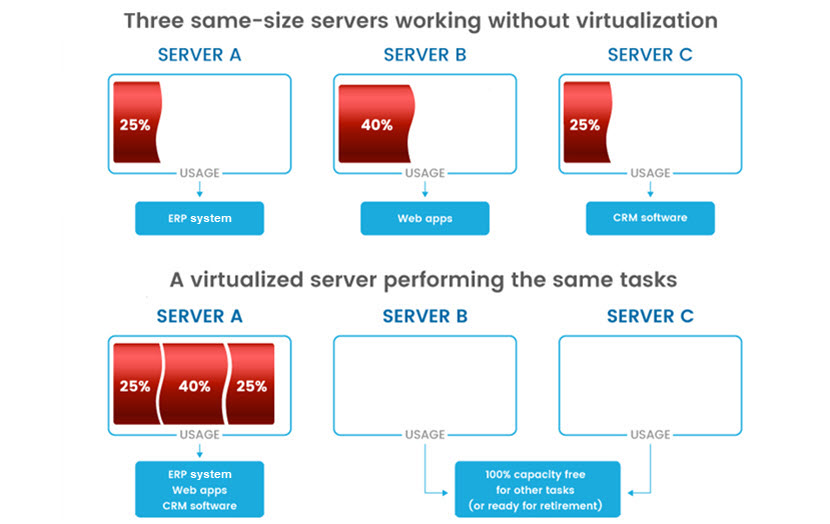
Types of Virtualization
Abstracting servers into multiple VMs is just one of several virtualization strategies companies use to streamline operations. Below are five other common types of virtualization that boost IT efficiency and cost-effectiveness.
Storage Virtualization
Storage virtualization abstracts physical storage resources (hard drives, SSDs, storage arrays, etc.) from the underlying hardware, allowing admins to manage them as a single pool of storage. Virtualized storage pools operate as a cohesive storage resource, which enables:
- More efficient use of storage capacity.
- Streamlined archiving, backup, and recovery procedures.
- Simplified storage management.
- Simpler data migrations.
Virtualizing storage enables the integration of devices from different vendors and disparate locations into a unified storage infrastructure. This integration maximizes existing investments and helps avoid vendor lock-in.
Storage virtualization also often includes thin provisioning capabilities, which allow admins to allocate storage capacity on demand rather than pre-allocating physical storage space. Thin provisioning helps optimize storage utilization and reduce waste.
Network Virtualization
Network virtualization abstracts network resources to enable the creation of multiple virtual networks on top of a shared physical infrastructure. Admins control abstracted resources without having to manage the underlying hardware, which dramatically simplifies network management.
Each virtual network operates as a logically separate entity with individual network policies, address space, and configurations. Traffic from one virtual network cannot directly access or interfere with traffic from another virtual network.
There are two types of network virtualization:
- Software-defined networking (SDN). SDN virtualizes the control plane (which determines how traffic is forwarded) and decouples it from the data plane (which actually forwards traffic). Software-defined control planes instruct hardware on how to direct traffic, which makes networks easier to manage.
- Network Function Virtualization (NFV). NFV virtualizes network appliances (routers, firewalls, load balancers, etc.) and turns them into software-based instances. NFV makes network appliances easier to configure, provision, and manage.
Network virtualization is vital for hybrid and multi-cloud connectivity. The tech enables seamless connections and workload mobility between on-prem and cloud-based resources, both of which are crucial to multi and hybrid cloud architectures.
Learn about SD-WANs and see how organizations build high-performing WANs with software-based network resources.
Data Virtualization
Data virtualization abstracts and integrates data from different databases, data warehouses, and services. As a result, you abstract the physical location, format, and structure of data from underlying data sources, presenting it in a logical, unified view to users and apps.
Data virtualization simplifies data storage and retrieval complexities, making data easier to access and utilize. This type of virtualization also makes it simple to integrate data from disparate sources, including:
- Different database types.
- Web services.
- Flat files.
- Cloud storage platforms.
Data virtualization also often includes aggregation, transformation, and enrichment of on-the-fly data. These features allow users to combine and manipulate data from different sources to meet specific business needs.

App Virtualization
App virtualization abstracts software apps from the underlying OS and encapsulates them into self-contained packages that run in isolation from the host environment. Virtualized packages contain everything the app needs to run, including all the necessary files, libraries, and dependencies.
Each virtualized app operates within a sandbox to prevent conflicts with other apps and system configurations. As a result, app virtualization helps resolve compatibility issues. For example, you can use this type of virtualization to run a Windows app on Linux or vice versa.
There are three types of app virtualization:
- Local app virtualization. In this approach, the entire app runs in a runtime environment on the endpoint device. Users install and execute the app locally, but the app operates within a virtualized environment isolated from the OS and other programs.
- App streaming. In this method, the app resides on a server that streams small software components or necessary data to the endpoint device. As a result, the app executes on the endpoint without requiring a complete install, reducing the resource requirements on the device.
- Server-based app virtualization (or app publishing). In this approach, the app runs entirely on a server or remote infrastructure. The server only transmits the app's user interface elements to the client device via a web browser or client interface.
Virtualized apps consume fewer system resources compared to traditional installations. These apps do not require users to modify system files or registry settings on incompatible devices, which leads to improved performance on host systems.
Desktop Virtualization
Desktop virtualization, also known as Virtual Desktop Infrastructure (VDI), involves hosting virtual desktops on a centralized server and delivering them to end-user devices over a local network or the Internet.
Instead of running desktop OSes and apps locally on their devices, users access virtual desktops remotely via PCs, laptops, tablets, or smartphones. This accessibility enhances mobility and enables remote work, allowing users to securely access virtual desktops from home, on the road, or in branch offices.
A virtualized desktop can be either persistent or non-persistent:
- Persistent desktops retain settings, files, and apps across sessions.
- Non-persistent desktops discard all changes made during the session after logout, providing a clean slate for the next user.
Desktop virtualization centralizes management tasks such as provisioning, patching, updating, and backups. Admins manage virtual desktops from a central console, making it easier to maintain consistency and security across all environments.
Learn about Desktop as a Service (DaaS), a technology that takes VDI to the next level by outsourcing all physical infrastructure management.
Practical Uses of Virtualization
Here are some practical uses of virtualization across various domains:
- Cloud computing. Virtualization is the foundation of cloud computing and is necessary for all cloud deployment models. The tech enables dynamic allocation of computing resources necessary for on-demand scalability.
- Network functions. Virtualizing network functions and services enables more efficient and cost-effective deployment and management of network services.
- Hardware consolidation. Virtualization allows organizations to consolidate multiple physical servers into fewer VMs. As a result, companies reduce hardware costs, power consumption, and their data center or server room footprints.
- Data analytics. Virtualization enables organizations to create virtual data lakes and analytics environments for processing and analyzing big data.
- Remote-first teams. In-house VDI and outsourced DaaS enable organizations to deliver desktop environments to employees over the Internet. Virtualized desktops enhance security and manageability, making them a natural fit with remote work and BYOD policies.
- Disaster recovery. Virtualization enables cost-effective disaster recovery by replicating and backing up virtualized workloads to remote data centers or cloud environments.
- Legacy app support. Virtualization enables you to encapsulate legacy apps and run them on modern hardware and OSes. That way, you extend the lifespan of legacy apps and reduce compatibility issues.
- Content Delivery Networks (CDNs). CDNs often rely on virtualization to improve the performance of web apps and streamed media. Virtualized caching servers and edge nodes distribute content closer to end-users, reducing latency and improving user experience.
- Multi-OS computers. Some users decide to run a hypervisor on a local computer to enable it to run several OSes. You can switch between different OSes without altering the primary OS.
- DevOps. Virtualization plays a key role in DevOps as the tech enables flexible on-demand development and testing environments.
Check out our article on DevOps virtualization to get an in-depth look at how DevOps engineers use VMs throughout the Software Development Life Cycle (SDLC).
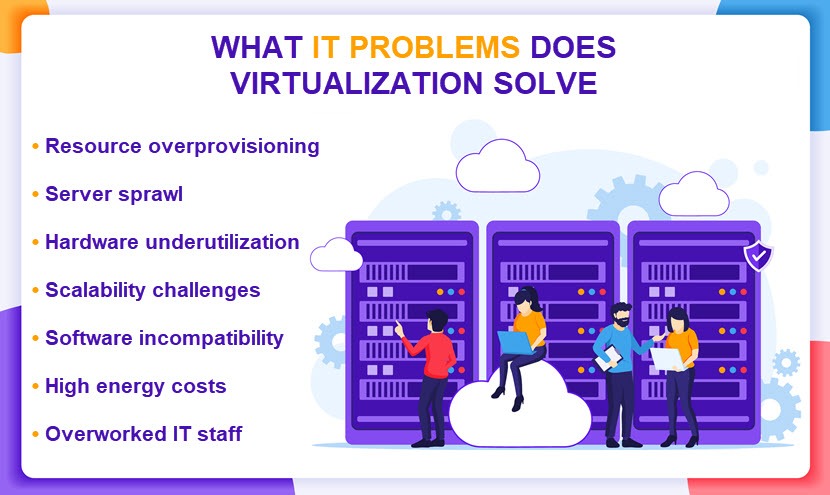
Virtualization Advantages and Disadvantages
Like all technologies, virtualization has both pros and cons you must know about before you start virtualizing parts of your IT infrastructure. Let's take a closer look at the main advantages and disadvantages of virtualization.
Advantages
Virtualization offers many benefits that drive IT efficiency and agility. By decoupling computing resources from hardware, virtualization transforms IT environments into dynamic, flexible, and cost-effective ecosystems.
Here are the main benefits of using virtualization:
- Centralized management. Virtualization centralizes management tasks such as provisioning, monitoring, and maintenance. Admins manage VMs through a unified interface or software-defined control plane, which streamlines administration and reduces operational complexity.
- Improved resource utilization. An average dedicated server uses only 15% of its resources during normal operation. Virtualization enables you to run multiple VMs on a single server, maximizing the use of each server's capacity.
- High scalability. Virtualization enables rapid scaling of IT infrastructure to accommodate changing workload demands. This agility supports business growth and fluctuations in resource requirements.
- Cost savings. Virtualization significantly reduces hardware costs by consolidating multiple VMs onto fewer physical servers. Adopters get to lower hardware acquisition costs and reduce maintenance expenses.
- Faster provisioning. Buying, installing, and configuring physical hardware is time-consuming. On the other hand, provisioning VMs is quick and easy, plus it can be done automatically.
- Improved security. Virtualization enhances security by isolating VMs from each other and the underlying hardware. As a result, adopters reduce the risk of malware infections, data breaches, and unauthorized access.
- Workload portability. Virtualized environments are platform-independent. VMs seamlessly run on different hardware platforms and migrate between on-prem and cloud environments.
- Reduced downtime. VMs move between physical hosts with minimal downtime, which makes it easier to ensure the availability of critical services. You can run multiple redundant VMs alongside each other and set up failover between them to ensure zero downtime during disruptive incidents.
Learn about high availability and the most effective ways to prevent costly service disruptions.
Disadvantages
While virtualization offers numerous benefits, the tech introduces a few drawbacks you must consider before adoption.
Here are the main disadvantages of virtualization:
- Performance overhead. The additional layer of abstraction between VMs and physical hardware introduces a slight performance overhead. This overhead can impact performance if you run resource-intensive workloads.
- New attack vectors. While beneficial to overall security, virtualization introduces a few new attack vectors. Adopters must account for VM escape vulnerabilities, hypervisor exploits, and guest-to-guest attacks.
- Resource contention. Virtualized systems can suffer from bottlenecks when VMs compete for shared resources. One VM monopolizing resources and impacting the performance of other VMs is a common issue if the adopter does not properly set up resource allocation.
- Storage overhead. VMs require disk space for storing virtual disks (VMDKs, VHDs, etc.) and snapshots, which introduces some storage overhead. Managing virtual storage resources requires careful planning to avoid sprawl and inefficiencies.
- Vendor lock-in. Organizations may become overly dependent on specific virtualization vendors and technologies. This vendor lock-in makes switching between platforms or migrating VMs to alternative solutions complex and costly.
- Shadow IT. Employees may deploy VMs without proper authorization or oversight from the security team. These shadow IT instances consume resources and often introduce new risks.
A Key Tech Both On-Prem and In the Cloud
For cloud providers, virtualization is a cornerstone technology without which the cloud computing model isn't feasible. For companies interested in in-house virtualization, hardware abstraction maximizes hardware investments and simplifies day-to-day management. Now that you know how virtualization works, you have all the info you need to assess whether your business would benefit from virtualized IT resources.

